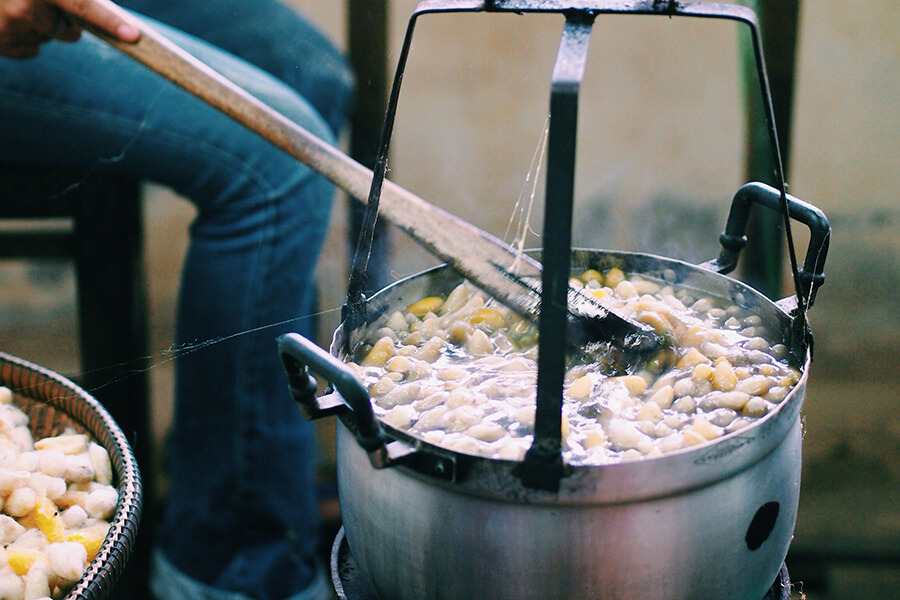Cambodia's Golden Silk has a rich history of silk production, with the country's Golden Silk industry standing out as a unique and valuable contribution to the world of textiles. This industry has been around for centuries and is deeply ingrained in the cultural and economic fabric of Cambodia. Go Cambodia Tours provides information about this traditional silk industry in Cambodia in this article.
Contents
History of Cambodia Golden Silk - Unique silk of Cambodia weaving industry
Golden silk also known as "silk of the gods," is made from the cocoons of the Golden silkworm, which is found in the forests of Cambodia. The silk produced from these cocoons is known for its beautiful golden hue, strength, and durability. It is used to create a variety of high-quality textiles, including clothing, scarves, and household items. Cambodian Golden Silk has a centuries-old tradition of handwoven silk that is known for its unique golden color and cultural significance. With high quality and unique designs, it is often featuring bold colors and intricate patterns.
Golden silk is used to weave and create a wide range of products, including clothing, scarves, home decor items, and accessories. Many silk products are sold in local markets and shops, as well as through online retailers and export markets. In recent years, there has been a renewed interest in Cambodian Golden Silk, both as a cultural treasure and as a source of economic development. Efforts have been made to preserve tradition and support the artisans who create this beautiful fabric. As a result, Cambodian Golden Silk has gained international recognition for its unique beauty and cultural significance.
The Process of Golden Silk Weaving
- Harvesting: The process starts with the harvesting of the silk cocoons from the Mulberry trees. The cocoons are then boiled to kill the pupae inside and loosen the silk fibres.
- Reeling: The silk fibres are then unwound from the cocoon by reeling them onto a spindle. The fibres are then spun into a continuous strand of silk thread.
- Dyeing: The silk thread is then dyed with natural or synthetic dyes to achieve the desired color.
- Warping: The dyed silk thread is then warped onto a loom to create the basic structure of the fabric.
- Weaving: The weaver then interlaces the silk thread to form intricate designs and patterns on the fabric.
- Finishing: The finished silk fabric is then washed, ironed and sometimes embroidered or decorated with gold or silver threads.
In recent years, the Cambodia golden silk industry has faced significant challenges, including a lack of funding and support, as well as competition from cheaper, mass-produced textiles from other countries. However, efforts are underway to revive this important industry and support the artisans and communities who rely on it.
Culture Significant of Cambodian Golden Silk
Cambodian Golden Silk is a vital part of Cambodian cultural heritage, and it is valued not just for its aesthetic beauty, but also for its deep cultural significance. Its use in traditional clothing and religious ceremonies has helped to preserve Cambodian culture and tradition for generations, and it remains an important symbol of Cambodian identity and pride. Cambodian weavers use specific motifs or symbols that have a cultural or religious significance, and may also incorporate gold or silver threads to add extra shimmer and luxury to the finished product. The average price for a meter of high-quality Golden Silk in Cambodia is around USD 30 to USD 40.
Cambodian Golden Silk is not only aesthetically beautiful but also deeply culturally significant. Its use in traditional clothing and religious ceremonies has helped to preserve Cambodian culture and tradition for generations, and it remains an important symbol of Cambodian identity and pride. Golden Silk garments are considered a symbol of prestige, wealth, and social status and are often worn by Cambodian royalty, high-ranking officials, and other elite members of society.
Despite facing significant challenges such as a lack of funding and support and competition from cheaper, mass-produced textiles from other countries, efforts are underway to revive this important industry and support the artisans and communities who rely on it.
Contemporary Uses of Cambodian Golden Silk
In recent years, Cambodian Golden Silk has been increasingly used in modern fashion and design, providing income and employment opportunities for local communities. Golden Silk is now being used to create a wide range of modern fashion items, including scarves, handbags, and dresses, which combine traditional Cambodian weaving techniques with contemporary styles. The use of Cambodia Golden Silk in modern fashion has also had a positive impact on Cambodia's economy. The production and sale of Golden Silk products provide income and employment opportunities for local communities, especially those in rural areas where weaving is a traditional skill passed down from generation to generation.
Exploring the Golden Silk Pheach
Taking a Cambodia tour to visit the Golden Silk Pheach - a Cambodian social enterprise that works to preserve the traditional Golden Silk industry and empower local artisans. Here, they produce high-quality, sustainable textiles and fashion items made from Golden Silk, and support the communities involved in this ancient craft. Their mission is to promote the value and beauty of Cambodian Golden Silk and ensure its survival for generations to come.
If you're interested in experiencing the beauty and cultural significance of Cambodia Golden Silk industry for yourself, consider booking a Cambodia tour package with Go Cambodia Tours.







